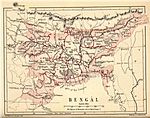
Back راجا غانيشا Arabic রাজা গণেশ Bengali/Bangla राजा गणेश Hindi ラージャ・ガネーシャ Japanese ರಾಜಾ ಗಣೇಶ Kannada Раджа Ганеша Russian ராஜா கணேசன் Tamil Раджа Ганеша Ukrainian
| Raja Ganesha | |
|---|---|
| King of Bengal | |
 A sketch of Raja Ganesha on the cover of a late 19th-century Bengali work, Raja Ganesh | |
| Sultan of Bengal | |
| Reign | 1414–1415 |
| Predecessor | Alauddin Firuz Shah I |
| Successor | Jalaluddin Muhammad Shah |
| Reign | 1417–1419 |
| Predecessor | Jalaluddin Muhammad Shah |
| Successor | Jalaluddin Muhammad Shah |
| Born | Ganesh Dinaraj Roy Bhaduri Bhavaniganj, Bengal Sultanate |
| Died | c. 1420 Sonargaon, Bengal Sultanate |
| Spouse | Tripura Sundari Devi,[1] Phuljani (widow of Ghiyasuddin Azam Shah)[2] |
| Issue | Jalaluddin Muhammad Shah |
| House | Ganesha dynasty |
| Religion | Hinduism |
| History of Bengal |
|---|
 |
Raja Ganesha was a zamindar ruler and the first Hindu Sultan of the Bengal Sultanate, who took advantage of the weakness of the first Ilyas Shahi dynasty and seized power in Bengal.[3] Contemporary historians of the medieval period considered him as an usurper. The Ganesha dynasty founded by him ruled over Bengal from 1415−1435.[4] His name mentioned in the coins of his son, sultan Jalaluddin Muhammad Shah as Kans Jha or Kans Shah.[5] The Indo-Persian historians mentioned his name as Raja Kans or Kansi.[6][3] A number of modern scholars identified him with Danujamardanadeva, but this identification is not universally accepted.[7] In the Arakanese accounts and also in Bengal and Mithila history, it is noticed that Raja Ganesha along with his Mithila Brahman friend, Raja Shiva Singh had combined their forces and defeated Ibrahim Sharqi of Jaunpur Sultanate who invaded Northern-Eastern India which created Bengal-Jaunpur conflict.[8]
- ^ Sanyal, D.C. "Social History of Bengal" (in Bengali). p. 73. Retrieved 29 December 2024.
- ^ Jagadish Narayan Sarkar, Hindu-Muslim relations in Bengal: medieval period (1985), p.52
- ^ a b Cite error: The named reference
:0was invoked but never defined (see the help page). - ^ Majumdar, R. C., ed. (1980) [First published 1960]. The Delhi Sultanate. The History and Culture of the Indian People. Vol. VI (3rd ed.). Bombay: Bharatiya Vidya Bhavan. p. 827. OCLC 664485.
- ^ Eaton, Richard Maxwell. (1993). The Rise of Islam and the Bengal Frontier, 1204–1760. Berkeley: California University Press. pp. 60, 60ff. ISBN 0-520-08077-7.
- ^ Majumdar, R. C., ed. (1980) [First published 1960]. The Delhi Sultanate. The History and Culture of the Indian People. Vol. VI (3rd ed.). Bombay: Bharatiya Vidya Bhavan. p. 205. OCLC 664485.
- ^ Mahajan, V.D. (1991). History of Medieval India (Muslim Rule in India), Part I, New Delhi: S. Chand, ISBN 81-219-0364-5, p.275
- ^ Eaton, Richard M. (1993). The Rise of Islam and the Bengal Frontier, 1204–1760. University of California Press. ISBN 978-0-520-20507-9. Archived from the original on 27 December 2023. Retrieved 27 December 2023.